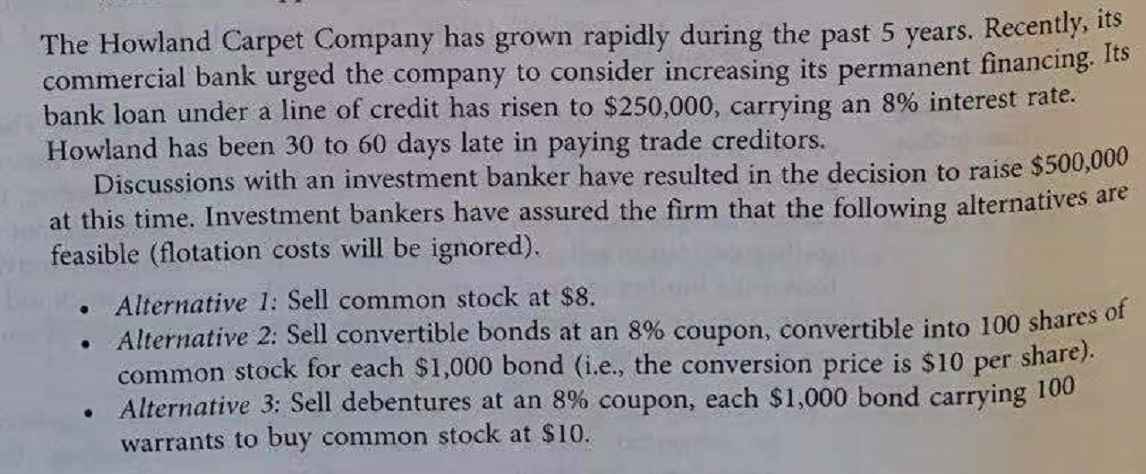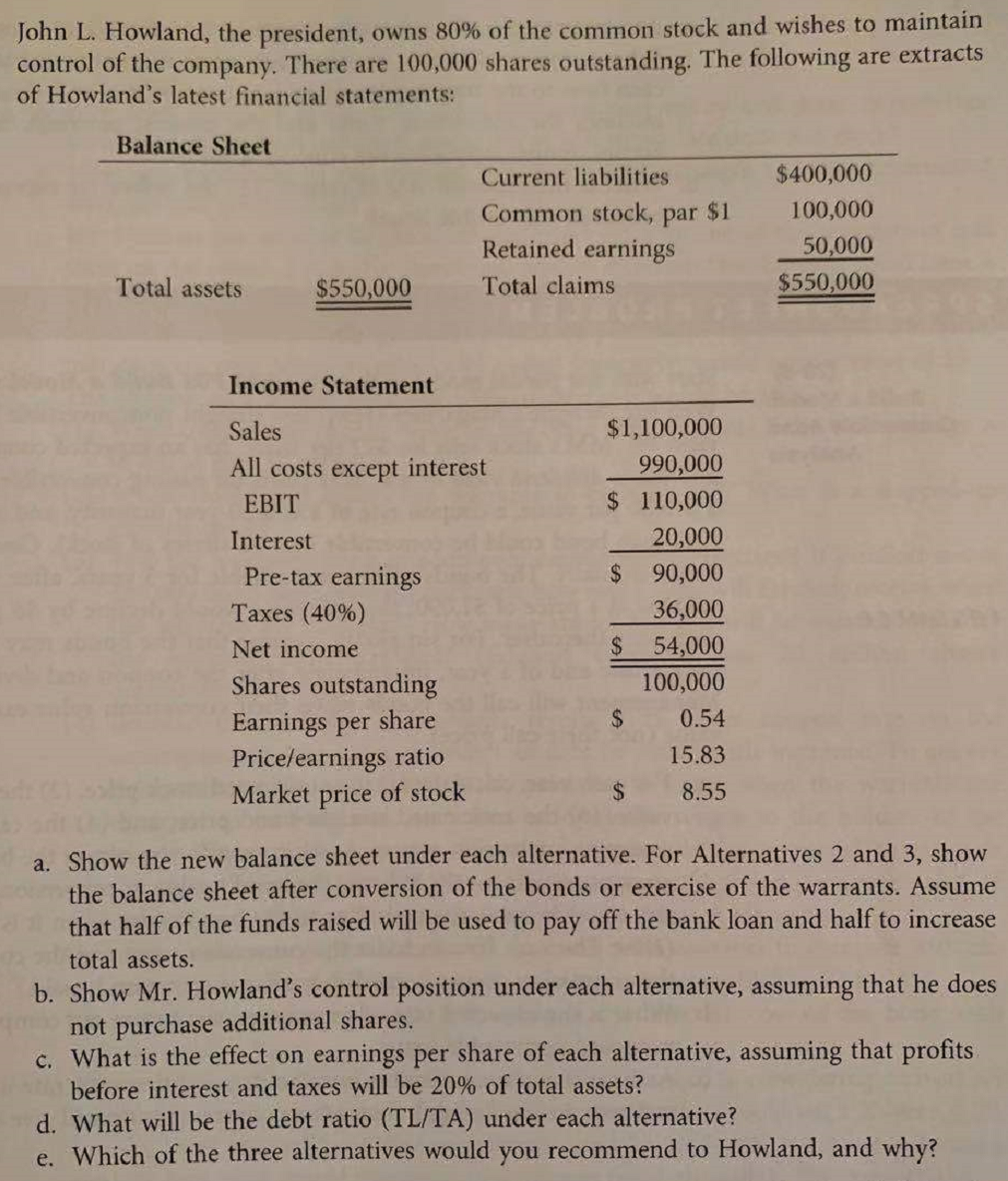The Howland Carpet Company has grown rapidly during the past 5 years. Recently, 5 commercial bank urged the company to consider increasing its permanent financing. Rs bank loan under a line of credit has risen to $250,000, carrying an 8% interest rate. Howland has been 30 to 60 days late in paying trade creditors. Discussions with an investment banker have resulted in the decision to raise $500,000 at this time. Investment bankers have assured the firm that the following alternatives are feasible (flotation costs will be ignored). Alternative 1: Sell common stock at $8. • Alternative 2: Sell convertible bonds at an 8% coupon, convertible into 100 shares of common stock for each $1,000 bond (i.e., the conversion price is $10 per share). Alternative 3: Sell debentures at an 8% coupon, each $1,000 bond carrying 100 warrants to buy common stock at $10.
The Howland Carpet Company has grown rapidly during the past 5 years. Recently, 5 commercial bank urged the company to consider increasing its permanent financing. Rs bank loan under a line of credit has risen to $250,000, carrying an 8% interest rate. Howland has been 30 to 60 days late in paying trade creditors. Discussions with an investment banker have resulted in the decision to raise $500,000 at this time. Investment bankers have assured the firm that the following alternatives are feasible (flotation costs will be ignored). Alternative 1: Sell common stock at $8. • Alternative 2: Sell convertible bonds at an 8% coupon, convertible into 100 shares of common stock for each $1,000 bond (i.e., the conversion price is $10 per share). Alternative 3: Sell debentures at an 8% coupon, each $1,000 bond carrying 100 warrants to buy common stock at $10.
Chapter16: Working Capital Policy And Short-term Financing
Section: Chapter Questions
Problem 14P
Related questions
Question
100%
Would you asnwer the last two questions Thanks!

Transcribed Image Text:The Howland Carpet Company has grown rapidly during the past 5 years. Recently, 1s
commercial bank urged the company to consider increasing its permanent financing. 1ts
bank loan under a line of credit has risen to $250,000, carrying an 8% interest rate.
Howland has been 30 to 60 days late in paying trade creditors.
Discussions with an investment banker have resulted in the decision to raise $500,000
at this time. Investment bankers have assured the firm that the following alternatives are
feasible (flotation costs will be ignored).
Alternative 1: Sell common stock at $8.
Alternative 2: Sell convertible bonds at an 8% coupon, convertible into 100 shares of
common stock for each $1,000 bond (i.e., the conversion price is $10 per share).
Alternative 3: Sell debentures at an 8% coupon, each $1,000 bond
carrying
100
warrants to buy common stock at $10.

Transcribed Image Text:John L. Howland, the president, owns 80% of the common stock and wishes to maintain
control of the company. There are 100,000 shares outstanding. The following are extracts
of Howland's latest financial statements:
Balance Sheet
Current liabilities
$400,000
100,000
Common stock, par $1
Retained earnings
50,000
Total assets
$550,000
Total claims
$550,000
Income Statement
Sales
$1,100,000
All costs except interest
990,000
EBIT
$ 110,000
Interest
20,000
Pre-tax earnings
2$
90,000
36,000
2$
Taxes (40%)
Net income
54,000
Shares outstanding
100,000
Earnings per share
Price/earnings ratio
Market price of stock
24
0.54
15.83
8.55
a. Show the new balance sheet under each alternative. For Alternatives 2 and 3, show
the balance sheet after conversion of the bonds or exercise of the warrants. Assume
that half of the funds raised will be used to pay off the bank loan and half to increase
total assets.
b. Show Mr. Howland's control position under each alternative, assuming that he does
not purchase additional shares.
c. What is the effect on earnings per share of each alternative, assuming that profits
before interest and taxes will be 20% of total assets?
d. What will be the debt ratio (TL/TA) under each alternative?
e. Which of the three alternatives would you recommend to Howland, and why?
Expert Solution
This question has been solved!
Explore an expertly crafted, step-by-step solution for a thorough understanding of key concepts.
This is a popular solution!
Trending now
This is a popular solution!
Step by step
Solved in 4 steps

Knowledge Booster
Learn more about
Need a deep-dive on the concept behind this application? Look no further. Learn more about this topic, accounting and related others by exploring similar questions and additional content below.Recommended textbooks for you

EBK CONTEMPORARY FINANCIAL MANAGEMENT
Finance
ISBN:
9781337514835
Author:
MOYER
Publisher:
CENGAGE LEARNING - CONSIGNMENT

Intermediate Financial Management (MindTap Course…
Finance
ISBN:
9781337395083
Author:
Eugene F. Brigham, Phillip R. Daves
Publisher:
Cengage Learning

EBK CONTEMPORARY FINANCIAL MANAGEMENT
Finance
ISBN:
9781337514835
Author:
MOYER
Publisher:
CENGAGE LEARNING - CONSIGNMENT

Intermediate Financial Management (MindTap Course…
Finance
ISBN:
9781337395083
Author:
Eugene F. Brigham, Phillip R. Daves
Publisher:
Cengage Learning